Upper Brighton
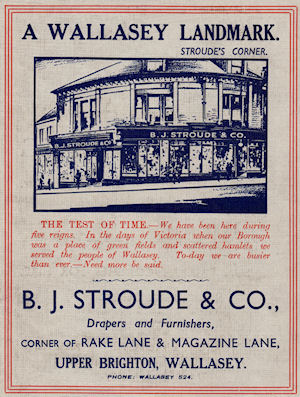 We begin looking at Upper Brighton from Rake Lane. The word "rake" is Old English for lane or incline, which would mean that Rake Lane becomes Lane Lane! The lane is one of the earliest public roads in Wallasey.
We begin looking at Upper Brighton from Rake Lane. The word "rake" is Old English for lane or incline, which would mean that Rake Lane becomes Lane Lane! The lane is one of the earliest public roads in Wallasey.
At the junction of Rake Lane and Magazine Lane was once a drapers shop owned by Benjamin Stroude who was also a member of the Wallasey Council. The building was built in 1891 and still takes the name of Stroude's Corner today. He also had a drapers shop at No. 14 Seaview Road. Before the shops were built there were two houses on the site which were called Honduras Villas.
Off Rake Lane, down the side of Howells DIY shop, is a passageway called Rock Cottages and it led to a row of 5 dwellings which were built in the 1800's. The houses survived into the 1950's before being demolished. On the other side of road of Rake Lane was Liscard Congregational Church and it was built in 1842 by John Astley Marsden of Liscard Castle at his own expense on his land. The Rake Lane Independent School was attached to the church and opened in 1866 as a Sunday school and in 1870 opened as a day school. During World War II the school hall was completely destroyed and was rebuilt in 1953. In 1974 dry rot made the church unsafe and it was demolished. The churchyard was unfortunately "bulldozed" at the same time, so that the graves disappeared, though a record of them has been kept by the church officials. The site is now occupied by a block of old people's flats, appropriately named 'Marsden Court'.
The chapel keeper of the church, who was also a gravedigger and chimney sweep. lived in one of the old cottages opposite which date from about 1790. Two of these cottages were once shops, one of which was 'Billy Breen's the Barber'. 'Stanley's Cask' the public house next door used to be the old Nag's Head, which was built in 1825.
Between Number 209 and 213 Rake Lane once stood the red brick building of the Welsh Presbyterian Church. When the Welsh church in Liscard Road closed down in 1966 the congregation moved here. Subsequently the Rake Lane building was demolished and there is now a block of flats.
In what is now Sandrock Close stood an old house called Belmont Villa, built about 1840. A professor of English literature Rev. James Cranbrook lived there in 1861. A furnace in the cellar heated the water for the greenhouse and outdoor swimming pool.
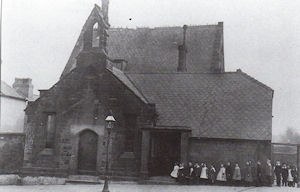 In Magazine Lane stands the nightclub, 'The Tav'. The building was originally St. James' Church of England School and was opened in 1847 to cater for the children of New Brighton. The school was affiliated to the parish of St. James Church in Victoria Road and was also known as Rock School. It continued to be used as a school until some of the classes were relocated to Egerton Street, next to the New Brighton Methodist Church. Both sites were used until the late 1930's when the pupils were transferred to Vaughan Road.
In Magazine Lane stands the nightclub, 'The Tav'. The building was originally St. James' Church of England School and was opened in 1847 to cater for the children of New Brighton. The school was affiliated to the parish of St. James Church in Victoria Road and was also known as Rock School. It continued to be used as a school until some of the classes were relocated to Egerton Street, next to the New Brighton Methodist Church. Both sites were used until the late 1930's when the pupils were transferred to Vaughan Road.
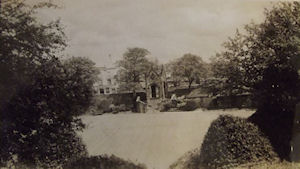 Rowson Street is named after James Atherton's son-in-law, William Rowson. On the left hand side of 'Upper' Rowson Street and on the corner of Mount Pleasant Road is the Quarry Recreation Grounds. This was once a quarry which was owned by Mary Ann Maddock, which, in turn, passed through the family and on to James Smith who converted it into a pleasant ground. The four-arched entrance is made of sandstone and contains an inscription which reads:
Rowson Street is named after James Atherton's son-in-law, William Rowson. On the left hand side of 'Upper' Rowson Street and on the corner of Mount Pleasant Road is the Quarry Recreation Grounds. This was once a quarry which was owned by Mary Ann Maddock, which, in turn, passed through the family and on to James Smith who converted it into a pleasant ground. The four-arched entrance is made of sandstone and contains an inscription which reads:
"Friend to the poor, generous promoter to all good works. Erected in 1912 A.D, in grateful remembrance of James Smith, 1841-1909, who converted this quarry into a pleasure ground".
When Wallasey Corporation took over the park, the amenities of two bowling greens, a rose garden and children's 'swings' area were laid out. Over the years, however the park became uninviting, the rose beds were grassed over, the play equipment was broken and the one remaining bowling green was virtually unusable. In September 1998 a public meeting was called and a group was formed called 'Reclaim The Quarry'. The members comprised of local residents, ladies from the Crown Green Bowling Club and young footballers. By the Summer of 2001 the park reopened with a new multi-sports pitch, new fencing round the bowling green and new equipment for the playground area.
Upper Rowson Street once had four impressive houses - 'Greenbank', 'Olinda', 'Dalmorton House' and 'Fern Hill'. Greenbank was once a well-known Dance Studio where many local people learnt to ballroom dance. At one time it was run by Reg and Nancy Rainford who were dance champions in the 1950's. None of these impressive houses remain today.
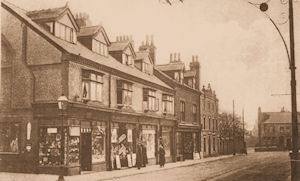 |
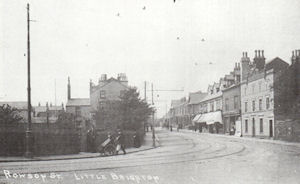 |
Rowson Street, c1910 |
Rowson Street, c1911 |
On Upper Rowson Street stands one of the oldest pubs in Wallasey, the Little Brighton Inn. The building was probably built about 1845 and has changed very little over the years. Originally the inn was called 'Chequers' but was renamed by Birkenhead Brewery, who owned the pub, to Little Brighton after the stretch of ground surrounding the inn which was known as the Little Brighton Common. The first landlord was Henry Evans who left by 1853 and was replaced by John Evans. He came from West Kirby and remained as licensee until 1865 when records show that William Jones became the new landlord. William remained at the inn until 1880 when Robert Voas took over. He was raised in Folly Lane, Wallasey Village. One reputed visitor to the Little Brighton Inn, which gave the pub the familiar nickname of 'The Ginnie', was Johanna Maria Lind (1820-1887), known affectionately as Jennie Lind. Whilst visiting Liverpool for a stage performance she is said to have crossed the river and stayed at the inn, where her name, or rather a corrupted version of her name, has endured ever since. Unfortunately, the claim that Jenny Lind was a guest at the inn lacks the authority of any form of historical evidence. It could well be the case that the choice of name for the inn was inspired by the great wave of popularity that swept through England in the late 1840's for the singer. The early 1870's marked the appearance of the Sandridge Hotel, built just across the road from the Little Brighton Inn, in Upper Rowson Street.
In the 1930's Bill Lloyd had the grocers at no.12 and next door was the post office on the corner of Manville Road and was kept by Mrs. Fitzgerald and later William Roberts. In later years Mr. Roberts established the builders firm W.H. Roberts.
On the right-hand side corner of Upper Rowson Street and Field Road (No.33 Rowson Street) is 'Richmond Villa'. It was built some time around 1840. Thomas Orton Goodwin and his family lived here in the 1800's. His father, John, was the founder of the Seacombe Pottery which stood where Kelvin Road is. Thomas Orton entered the business as a partner in 1856 when his father retired. Unfortunately in 1864 a large uninsured consignment of products was lost at sea on the way to America, resulting in a financial and embarrassing loss which saw the factory close. The Goodwins moved to 148 Wheatland Lane where Thomas Orton died in 1873 and is thought to be buried at St. Hilary's Church. In 1900 Mrs. Annie Fox is noted living at the house. In the 1920's the property was divided into three apartments with Mr. George Harrison, then a clerk, lived in one flat and Mrs. Laura Bates and Mrs. Eva Levis lived in the other two.
Next door at No.35 is 'The Lodge'. The house was built somewhere around 1780 and is found on old maps of New Brighton before the area was developed. The house is constructed of uncut sandstone block, which is not usually seen in Wallasey. The front of house has been rendered and a porch and front door was added at a later date. Living at No. 37 in 1911 was John Hughes, a pilot. Mrs. Elizabeth Hughes stayed on after her husbands death and then Alvin Thomas Willis came to live in the house in the 1930's. He was a cinema manager. Living at no. 39 was Harry Williams. He was a timber merchant and the house was aptly named 'Woodcroft'. It was once the Corbar Girls' Collegiate School, both "day" and "boarding". M. Hammersely was the Principal.
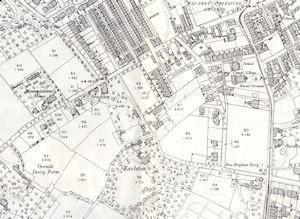 |
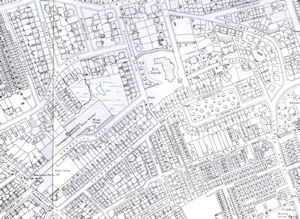 |
Upper Brighton (south), 1898 |
Upper Brighton (north), 1935 |
Continuing down the hill of Upper Rowson Street is 'Rowson Mount' at No.41 with Robert Pruddah residing here in 1911. He was a High Bailiff. By about 1923 Henry Osborne Cater lived at the house and by the 1930s it then became Rowson Mount Nursing Home with Mrs. R. Carr as principal. Mrs. Claxon lived at No. 43 'Crest Bank' and Frank Peter was a wine merchant who came to live there by 1911. By the 1930's the house was divided into three apartments.
Looking at St. James Road in 1911 some of the people who lived here was Joseph Clementine at 'Lismere' (No.1) and next door lived Livingstone Holmes, a ship's store dealer, at 'Hantsport'. William and Elizabeth Naylor lived at 'Allandale' and a little further along at 'York Lodge' we find George Clark, a wine and spirit merchant. Fidel Fernandez Valle, a merchant, resided at 'Seabourne'. At No. 31 and 33 are two impressive buildings, 'Rutland' and 'Rock Cottage' where William Rock, an accountant, and Herbert Maw, chartered accountant, lived respectively. Police Constable Henry Whittaker lived at 'The Lodge' and Richard O' Donovan who was a foreign correspondent lived at 'Woodbine Cottage' (no.18).
Standing at No. 1 - 3 St. Georges Mount is a large house which was once called 'Rutland House' and was once the home of Dr. William Bell. He was a Physician to New Brighton Convalescent Home in Rowson Street. He was also responsible for the establishment of the Wallasey Cottage Hospital, was a Justice of the Peace and served on the management of both Wallasey High School and Wallasey Grammar School. All the land that today is St. Georges Park was sold in 1922 to the Wallasey builder Moses Hughes. He commenced building new houses but the centre section was sold in 1926 to the Wallasey Corporation for £1,165 and this now forms the pleasant fenced off area of parkland. By the 1930's Rutland House was divided into three apartments. Charles Ellibeck, chartered accountant, lived at no.1, Marguerite Saul lived at no.2 and at no.3 was the broker John Rideing.
Going up St. Georges Mount we had Mrs. Winifred Hodgson at 'Woodcote' and the accountant Richard Smye lived at 'Hillside'. Three lots of families lived at 'Priory Nook' (no.11), Thomas Mayall, John Murray and Miss Mary Milliken. A Mr. Albert Mead also once lived in the large house.
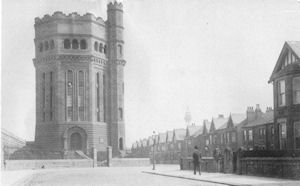 Gorsehill Road once had allotments which were situated on the left hand side. Numbers 45 to 55, which were built in the mid 1950's, now occupy the site. New Brighton Water Tower opened in February 1905, the same time as the second reservoir. The two covered reservoirs had a combined capacity of over six million gallons; the first one being opened in 1887. They were fed by local well water in Liscard and from Lake Vyrnwy in North Wales, operating until May 1941 when they were damaged by a high explosive bomb and not fully repaired until 1948. Next to the water tower is the Gorse Millennium Green. The land was formerly owned by North West Water and was a natural habitant for wildlife since the building of the water tower. The Save The Gorse community group managed to secure funding which enabled them to purchase the land and Groundwork Wirral was enlisted to help draw up plans for a 'pocket park'. The front of the site is now an open area with pathways and seats around a giant sundial with the surrounding planting representing the four seasons.
Gorsehill Road once had allotments which were situated on the left hand side. Numbers 45 to 55, which were built in the mid 1950's, now occupy the site. New Brighton Water Tower opened in February 1905, the same time as the second reservoir. The two covered reservoirs had a combined capacity of over six million gallons; the first one being opened in 1887. They were fed by local well water in Liscard and from Lake Vyrnwy in North Wales, operating until May 1941 when they were damaged by a high explosive bomb and not fully repaired until 1948. Next to the water tower is the Gorse Millennium Green. The land was formerly owned by North West Water and was a natural habitant for wildlife since the building of the water tower. The Save The Gorse community group managed to secure funding which enabled them to purchase the land and Groundwork Wirral was enlisted to help draw up plans for a 'pocket park'. The front of the site is now an open area with pathways and seats around a giant sundial with the surrounding planting representing the four seasons.
Dominating the New Brighton skyline is the imposing building of SS. Peter and Paul Church with its copper-covered dome. The foundation stone was laid in 1932 and the first mass took place on 2nd August 1935. In 1951, on the land at the side of the church, the new primary school was built, taking pupils from the old school in Hope Street.
In 1832 James Atherton, a Liverpool merchant, invested in the sand-hills and heath and named the area for development New Brighton after Brighton the fashionable resort on the Sussex coast. Atherton Street is a reminder of this entrepreneur. His first property venture was in Everton in the area surrounding St. George's Church. So he called one of his streets St. Georges Mount, where all the superior residences had uninterrupted views of the sea and river.
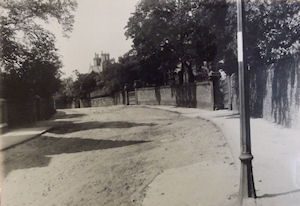 |
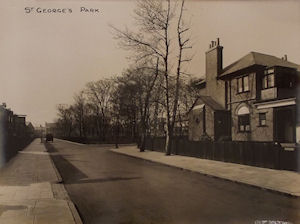 |
St. George's Mount |
St. George's Park, 1927 |
On the corner of Atherton Street and St. Georges Mount was a house called Monte Belle which was built in 1860 for Charles Pickering (Pickering Road was named after him). The coach house and stable buildings are still standing opposite. Built about the same time, the next house was called The Grennan and it was characterised by an observation tower on the roof. By the 1980's the house was demolished and, in later years, Grennan Court together with the cul-de-sac called The Grennan was built on the site.
In St. George's Park stands the impressive house, Stanley Rock. The house was built long before James Atherton and William Rowson purchased most of the surrounding land. It was built for Gerard Stanley who married Mary Meddowcroft in 1778. Mary was the daughter of Edmund Meddowcroft who, at that time, owned all the land now covered by the park and stretching as far south as Mount Pleasant Road. The building had since had an extension constructed at the side and is divided vertically so that one entrance is in St. George's Mount and the other in the Park.
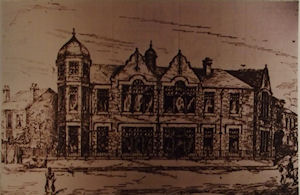 |
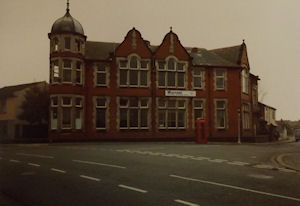 |
Wallasey Technical School, c1903 |
Wallasey Technical School, 1983 |
At the junction of Upper Rowson Street and Field Road were once gates known as New Brighton Gates, which had a sign indicating Upper Brighton. On the left-hand side corner of Field Road and Upper Rowson Street once stood the Wallasey Technical School which opened in 1901 to offer technical and manual instruction at senior level. Technical and commercial education had originally took place at 'Field Road Mission', which opened in 1889. The building still stands today and houses Clement Glazing. After reorganisation, the Wallasey Technical School became the annexe to the new school built in Coronation Avenue. The Field Road School was used as the Commercial Department offering bookkeeping, shorthand and typing to senior girls. When it was no longer required it was used by the Wirral College of Art. The school was demolished in the late 1980s and new purpose-built flats now occupy the site.
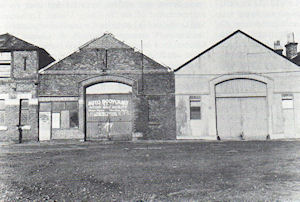 In Field Road stands five houses known as 'Busby Cottages' which were built in 1891 for staff employed at the Tramway depot. They were built by Robert Busby who was the owner of Wallasey United Tramways. The depot and stables for the tramways were built in 1879 by the local contractor, Mr. Ridehalgh. The building comprised a central yard 124ft by 40ft with two tracks branching from just inside a 12ft wide door. The glass and zinc roofing was supplied by Busby & Co. Four stables each of ten stalls ran the length of the east wall except at the road end where there was a two-storey house of the Manager. On the west side there another stable for ten horses, a smithy, two loose horse boxes for isolation purposes, an engineer room with a 40ft chimney, a mess room, and a small office. When the Council vacated the premises in 1901 the tramways buildings was sold to the funeral directors, J. McKenna, for £1,450, who occupied them for many years. Later the sheds were used as garages for the buses. By the early 1990s the buildings were demolished.
In Field Road stands five houses known as 'Busby Cottages' which were built in 1891 for staff employed at the Tramway depot. They were built by Robert Busby who was the owner of Wallasey United Tramways. The depot and stables for the tramways were built in 1879 by the local contractor, Mr. Ridehalgh. The building comprised a central yard 124ft by 40ft with two tracks branching from just inside a 12ft wide door. The glass and zinc roofing was supplied by Busby & Co. Four stables each of ten stalls ran the length of the east wall except at the road end where there was a two-storey house of the Manager. On the west side there another stable for ten horses, a smithy, two loose horse boxes for isolation purposes, an engineer room with a 40ft chimney, a mess room, and a small office. When the Council vacated the premises in 1901 the tramways buildings was sold to the funeral directors, J. McKenna, for £1,450, who occupied them for many years. Later the sheds were used as garages for the buses. By the early 1990s the buildings were demolished.
Next to the Technical School and standing off Field Road stood Florence Cottages. Theses were mainly four-roomed cottages with no bathrooms. Next along the road once stood the Congregational Mission Hall which opened in 1898. Today the building still stands and is used by Clements Glass Windows. A little further along, which have now disappeared, stood Catherine Road and Eleanor Road. A row of six houses were situated between the roads (No 25-35) and were called Dinorben Terrace. Another terrace of houses that no longer stand today where Constatine Terraces which were a row of six houses that stood off Field Road opposite Number 38.
Residing at number 6 Field Road in the 1880s was Charles Finlay, his wife and five children. Charles had been in the employ of the Wallasey Local Board for many years as a Ferry Stageman at New Brighton and was well liked. He was also a volunteer for the New Brighton Lifeboat and in the early hours of Friday, 29th January 1883, was called into action when a strong gale blew over the Mersey. Three ships in the mouth of the river sent rockets up into the air for assistance. The New Brighton lifeboat headed out but was struck by heavy seas which washed three of the crew overboard. Two of the three succeeded in being saved but the third, Charles, unfortunately drowned. He was 38 years of age. Six hours later his body was found and he was taken to Liverpool's mortuary at Prince's Dock. His coffin was carried from Field Road, draped in an Union Jack, to his burial place at Liscard Congregational Church in Rake Lane. Nearly three hundred people attended his funeral. Such was the public feeling of sadness that Charles had left a widow and five children unprovided (the oldest was 13 years old) that donations were collected for the care of his family - totaling over one-thousand pounds.
At Number 12 Field Road was once the Virginia Steam Laundry. The business was started by Mrs. Sheldon who started the laundry service in the early 1900's at number 13 Tollemache Street in New Brighton, when she installed gas boilers for the purpose. From here she moved the business to Virginia Road where she called it the 'Virginia Steam Laundry'. The Tollemache address became the Receiving Office. From here she moved up to Field Road. Living at No.10 Field Road in 1911 was Percy Sheldon, and, with his brother Edward, were devout (Plymouth) Brethren and did much in the founding of Hebron Hall in Liscard. They both did outside preaching on New Brighton shore. By the 1930's Edward was residing at No.10 with his sister, Mabel, living next door at No. 8.
There was another Mission on Field Road and it stood next to no. 38. It was run by the Methodists and known as 'Chapel of the Good Shepherd', although it was also called 'Church House For The Relief Of The Sick And Needy'. There was no D.H.S.S in those days and many people received help from the Mission. The needy were provided with clothing and boots, etc. When the mission was demolished 'Sefton Hall' was built on the site. The Hall was originally a concert hall and was a popular place for enjoying concerts. The hall was a long building and had two front entrances. The hall was demolished in the 1980's and was used for a time by Pickford's Storage.
Continuing on from Field Road is Bromley Road which was at one time covered in sand dunes and gorse bushes until the bungalows were built in 1923. The properties cost £375 each and were built by a man named Daniel Lyons who, sadly, committed suicide by drowning.
On Mount Road was St. Hilary School for Girls which was housed in 'The Mount'. The school was run by two Whiteway sisters, Mary being the headmistress and her sister, Edith the music mistress. The school was founded in the early 1900's and was in existence for a considerable number of years. The entrance to the school was in Mount Road (which was named after the house). There girls did not use this entrance but entered the school from Stoneby Drive. The house itself was built in 1835 and was demolished by the late 1930's to make way for the completion of Stoneby Drive.
Another large house on Mount Road was 'Sudworth House'. Maps of 1841 has the house belonging to Thomas Sudworth who more than likely had the property built. Sudworth Road is named after the house. Mrs. Caroline Mahler lived in the large house for some time. Her daughter, Emma, was a Justice of the Peace. The house and grounds were sold for development in 1923.
Another interesting property stands on the corner of Mount Road and Sudworth Road, 'Stoney Hey'. Richard Hulse. a Cotton Broker, once lived at the house in 1911. By 1938 his daughter, Miss Sarah Hulse, was residing there. After the war Frank Linacre, a plumber, bought the property. His daughter married Archie Wells, the New Brighton Footballer who played at the Tower Stadium between 1946-1949 and scored four goals in 37 appearances.
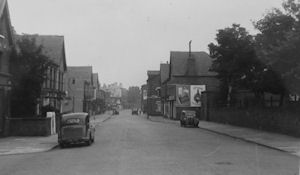 |
Mount Pleasant Road, looking east from near Mount Road, 1952 |
At the junction of Mount Pleasant Road and Kirkway once stood the house 'Breck Hey'. The house. fronting on to Mount Pleasant Road opposite the beginning of Mount Road, was occupied by Alderman T. Raffles Bulley, a magistrate and the brother of Samuel Bulley who founded Ness Gardens. Alderman Bulley was a Socialist who helped the poor who lived in the area. Where Oarside Drive is now was Oarside Dairy Farm with a large field of cows and a fleet of horse-drawn milk flats. It was one of the first dairies to have bottled milk.
As we continue along Earlston Road we enter a most intriguing part of Wallasey with an unsolved mystery from early history. The township boundaries were formerly between Wallasey to the west and Liscard to the east approximately 150 yards north of Captain's Pit. The Old Manor House of Liscard originally stood on the site of what is now the children's library (until 1847 when the title was transferred to a house at the bottom of Manor Lane.) Although little is known about the early manor house it was probably built in medieval times of natural stone. In the Vyner survey of 1665 Liscard Township appears to have been a group of old enclosures stretching from this Manor House to the yards and crofts at the backs of the houses in Liscard Village.
It is possible that a chapel was built adjacent to the manor house and this could be how Kirkway got its name. "Kirk" is the Anglo-Saxon word for church, although there has been no tangible evidence of such a building. Kirk Cottages built in 1829 replaced the original earlier one, owned by the Molyneux family, which bore the same name. Situated where the cemetery is now was a field called Old Town Hey, which suggests that this was the heart of ancient Liscard - the name means "Fort on the Heights". Henry Robinson (1640-1727), who was master of the Free Grammar School, wrote the Account of Wallasey. In it he described "As there was a great man called Wally, so there was a great man called Lee and his town stood near the Kirk westward of the Kirkway as by the closes called Old Town Heys, and other Calant Signes which have been found by Digging appears".
Earlston House (at one time called Rosebank) had part of the Old Liscard Manor House incorporated in it and is now the children's library. Initially owned by John Astley Marsden the grounds covered 23 acres stretching down as far as Seaview Road. It was occupied by George Grant a partner in a firm with Sir John Gladstone MP the father of William Ewart Gladstone (later Prime Minister). Subsequently the house was owned by Thomas Addison a stockbroker, then Robert Bell, a tea merchant, then Lowry Mann (Bell's son-in law) and finally by Anthony Smith a cotton broker. Mr. Smith died in 1898 and the Wallasey Corporation purchased the property for £20,000, the library opening the following year. A wing of the old house was lost during an air raid during World War II and the site is now a car park.
In 1908, with a £9,00 grant from the Carnegie Trust, an extension was built and this now serves as Wallasey Central Library. Andrew Carnegie was a philanthropic millionaire who contributed to libraries and universities. During World War 1 a caretaker hanged himself over the archway between the two buildings. The passageway above is alleged to be haunted by his ghost.
In 1880 ten acres of land was purchased to form Rake Lane Cemetery. In 1898 the remaining twenty-three acres of the Earlston estate was purchased from the executors of the late Anthony Smith. The land now forms Earlston Road, the former Earlston Gardens and the cemetery.
On Mount Pleasant Road in early times stood a ship's chandler store that also sold ale and the present building, built in 1841, was called the Telegraph Tavern. It stands on a high point with a seascape of Liverpool Bay and the River Mersey as well as across to the telegraph station on Bidston Hill. It is easy to imagine that, in the early days before more sophisticated methods of communication and with few buildings to obstruct the view, signals could be sent from vessels in the bay via the telegraph to the port of Liverpool. Messages in those days were sent using semaphore flags or optical telegraph paddles. About 1900 the grocery business at the inn was relinquished, and it continued to sell just the ale until applying for a spirits licence in 1964.
References
Upper New Brighton, A Local History Trail - Therese Irving
Almost An Island - Noel E. Smith
Sandstone & Mortar - Noel E. Smith
Yesterday's Wirral - Ian and Marilyn Boumphrey
The Rise And Progress Of Wallasey - E.C. Woods and P.C. Brown
Featured sites
- Non Gamstop Casinos
- Casino Not On Gamstop
- UK Casinos Not On Gamstop
- Non Gamstop Casinos UK
- Sites Not On Gamstop
- Sites Not On Gamstop
- Casinos Not On Gamstop
- Casinos Not On Gamstop
- Casinos Not On Gamstop
- Non Gamstop Casino UK
- Casinos Not On Gamstop
- Non Gamstop Casino
- UK Online Casinos Not On Gamstop
- UK Online Casinos Not On Gamstop
- Non Gamstop Casinos
- Casino Sites Not On Gamstop
- Casinos Not On Gamstop
- Casinos Not On Gamstop
- Best Betting Sites
- Casinos Not On Gamstop
- Gambling Sites Not On Gamstop
- Betting Sites That Are Not On Gamstop
- Non Gamstop Casinos UK
- UK Online Casinos Not On Gamstop